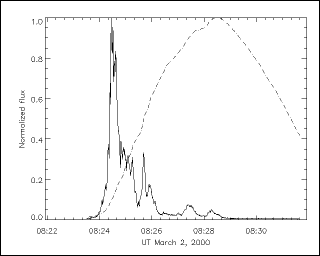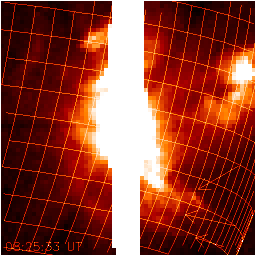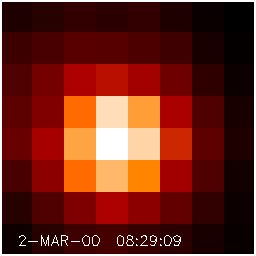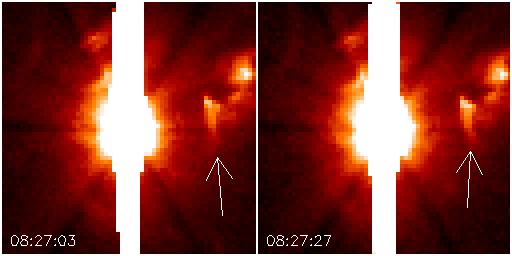
A "sympathetic flare" is one resulting from a perturbation caused by another flare. On March 2 we had our second X-class flare of the year 2000, and it displayed powerful ejecta that clearly perturbed some nearby structures but not others. Here's a summary plot of the light curves, GOES soft X-rays (1-8 A) and Yohkoh HXT hard X-rays (33-53 keV; the soft X-rays, the dotted line, appear to integrate the hard X-ray light curve - the Neupert effect:

Obviously, as we've seen in these nuggets many times, a powerful flare such as this behaves in some ways like a magnetic explosion. This one is no exception, with successive ejection of fragmented and loop-like structures in a direction roughly consistent with the local solar vertical (image on the left below; ignore the bright vertical saturation spike, and the radial features, an artifact of the intensity and compactness of this event):

|

|
The arrows at the lower right point to bits of the stuff flying away from the flare core. They are going to the lower right, and disk center is at the upper left. The flare core is amazingly compact, as is often the case for these very impulsive events, and has a density approaching 10^12/cm^3. The image on the right above shows a blown-up view of flare maximum in soft X-rays: the image on the left has a width 128 pixels, and the one on the right only 8! Each pixel is about 2,000 km on the Sun.
Below is the sympathetic event, shown by the arrows:

One can see from the time labels that the excitation of this feature lags behind the time of ejection, which matches the time of the impulsive hard X-ray burst typically well. Please see the MOVIE to get the time relationships straight. According to NOAA's Gopher service, the Type II burst started at 08:27. The feature flares up and bends as though to follow the blast emanating from the flare core. Other features at comparable distances show no effect! This is typical behavior for a flare; catastrophic changes in the emitting material, and often no dynamics at all in nearby features. From this one concludes that some parts of these regions must have much higher magnetic pressure than gas pressure.
We don't have time to describe it, but Larry Hovland (who incidentally built the CCD camera for SXT) noted a remarkable feature in the data this week - a persistent extremely thin spike at the NW limb. Thanks for the tip, we'll hope to analyze this later on. We also had spectacular trans-equatorial loop systems, often the subjects of SXT science nuggets.
March 4, 2000
H. Hudson (hudson@isass0.solar.isas.ac.jp)